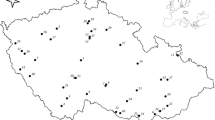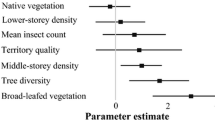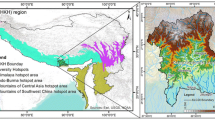Abstract
The European landscape is under pervasive attack of massive land use changes, such as agricultural intensification, urbanization and land abandonment. These changes resulted in population decline of birds living in open habitats. Despite a good understanding on the effects of these driving forces on bird populations, effective conservation actions are difficult to conduct as these forces are closely connected with socioeconomic development of particular countries and thus almost impossible to reverse. It is hence necessary to conserve refuge sites with a limited influence of these negative factors. We surveyed birds in 42 abandoned military training sites (AMTS) in a central European country, the Czech Republic, and we have found these sites are valuable, and to date overlooked, refuges for bird conservation. Birds of high conservation concern and open habitats birds (such as Miliaria calandra, Saxicola torquata or Lullula arborea) were more abundant in AMTS than predicted by their total population size in the Czech Republic. The most important characteristics predicting attractiveness of AMTS for birds of conservation concern were low altitude, low proportion of forest/dense scrubland, high proportion of sparse scrubland/bare ground and large area. Former military activity was beneficial for declining open habitat birds by maintaining moderate disturbance levels, which are rarely found elsewhere in current landscapes. Owing to reduction of armed forces across Europe AMTS provide continental-wide network of high-quality sites for bird conservation. Nevertheless, AMTS are subject to pressure from building activities or loss of openness due to overgrowth of forest or scrub plant communities.

Similar content being viewed by others
References
Althoff DP, Rivers JW, Pontius JS et al (2004) A comprehensive approach to identifying monitoring priorities of small landbirds on military installations. Environ Manage 34:887–902
Beale CM, Lennon JJ, Yearsley JM et al (2010) Regression analysis of spatial data. Ecol Lett 13:246–264
Beneš J, Kepka P, Konvička M (2003) Limestone quarries as refuges for European xerophilous butterflies. Conserv Biol 17:1058–1069
Bibby CJ, Hill DA, Burgess ND et al (2000) Bird census techniques, 2nd edn. Academic Press, London
Borregaard MK, Rahbek C (2010) Causality of the relationship between geographic distribution and species abundance. Qr Rev Biol 85:3–25
Burnham KP, Anderson D (2002) Model selection and multimodel inference. A practical information-theoretic approach, 2nd edn. Springer, New York
Chamberlain DE, Fuller RJ, Bunce RGH et al (2000) Changes in the abundance of farmland birds in relation to the timing of agricultural intensification in England and Wales. J Appl Ecol 37:771–788
Cramp S (1988) Birds of western palaearctic, vol 5. Oxford University Press, Oxford
Cully JF, Michaels HL (2000) Henslow’s sparrow habitat associations on Kansas tallgrass prairie. Wilson Bull 112:115–123
Cully JF, Winter SL (2000) Evaluation of land condition trend analysis for birds on a Kansas military training site. Environ Manag 25:625–633
Devictor V, Julliard R, Couvet D et al (2007) Functional homogenization effect of urbanization on bird communities. Conserv Biol 21:741–751
Donald PF, Sanderson FJ, Burfield IJ et al (2007) International conservation policy delivers benefits for birds in Europe. Science 317:810–813
Gaston KJ, Lawton JH (1990) Effects of scale and habitat on the relationship between regional distribution and local abundance. Oikos 58:329–335
Grzybek J, Michalak I, Osiejuk TS et al (2008) Densities and habitats of the Tawny Pipit Anthus campestris in the Wielkopolska region (W Poland). Acta Ornithol 43:221–225
Hersperger AM, Burgi M (2009) Going beyond landscape change description: quantifying the importance of driving forces of landscape change in a central Europe case study. Land Use Policy 26:640–648
Hirst RA, Pywell RF, Marrs RH et al (2005) The resilience of calcareous and mesotrophic grasslands following disturbance. J Appl Ecol 42:498–506
Honkanen M, Roberge J-M, Rajasärkkä A et al (2010) Disentangling the effects of area, energy and habitat heterogeneity on boreal forest bird species richness in protected areas. Glob Ecol Biogeogr 19:61–71
Husáková J, Sádlo J, Vĕtvička V (1992) Terrae incognitaque prohibitae-military exercize terrirories and nature-part II-the seamy side: territories extremely destroyed. Ochrana přírody 47:67–71
Jackson SF, Gaston KJ (2008) Incorporating private lands in conservation planning: protected areas in Britain. Ecol Appl 18:1050–1060
Jentsch A (2007) The challenge to restore processes in face of nonlinear dynamics? on the crucial role of disturbance regimes. Restor Ecol 15:334–339
Jiguet F, Gadot AS, Julliard R et al (2007) Climate envelope, life history traits and the resilience of birds facing global change. Glob Ch Biol 13:1672–1684
Johnson JB, Omland KS (2004) Model selection in ecology and evolution. Trends Ecol Evol 19:101–108
Julliard R, Clavel J, Devictor V et al (2006) Spatial segregation of specialists and generalists in bird communities. Ecol Lett 9:1237–1244
Kade A, Warren SD (2002) Soil and plant recovery after historic military disturbances in the Sonoran Desert, USA. Arid Land Res Manag 16:231–243
Kerbiriou C, Le Viol I, Jiguet F et al (2009) More species, fewer specialists: 100 years of changes in community composition in an island biogeographical study. Diver Distrib 15:641–648
Koleček J, Reif J, Šťastný K et al (2010) Changes in bird distribution in a Central-European country between 1985–1989 and 2001–2003. J Ornithol 151:923–932
Kuźniak S, Bednorz J, Tryjanowski P (2001) Spatial and temporal relations between the Barred Warbler Sylvia nisoria and the Red-backed Shrike Lanius collurio in the Wielkopolska region, W Poland. Acta Ornithol 36:129–133
La Sorte FA, McKinney ML (2007) Compositional changes over space and time along an occurrence-abundance continuum: anthropogenic homogenization of the North American avifauna. J Biogeogr 34:2159–2167
Laube I, Breitbach N, Böhning-Gaese K (2008) Avian diversity in a Kenyan agroecosystem: effects of habitat structure and proximity to forest. J Ornithol 149:181–191
Lauver CL, Busby WH (2002) Testing a GIS model of habitat suitability for a declining grassland bird. Environ Manage 30:88–97
Lepš J, Šmilauer P (2003) Multivariate analysis of ecological data using CANOCO. Cambridge University Press, Cambridge
Ludwig T, Storch I, Gartner S (2009) Large-scale land use change may explain bird species declines in semi-natural areas: the case of black grouse population collapse in Lower Saxony, Germany. J Ornithol 150:871–882
Manigart P (2006) Restructuring of the armed forces. In: Caforio G (ed) Handbook of the sociology and the military. Springer, New York
McKinney ML, Lockwood JL (1999) Biotic homogenization: a few winners replacing many losers in the next mass extinction. J Biogeogr 14:450–453
Ministry of the Environment of the Czech Republic (2005) CORINE landcover database 2000. Ministry of the Environment of the Czech Republic, Praha
Ministry of the Environment of the Czech Republic (2008) Decree of the Ministry of the Environment of 11 Jun 1992, implementing 356 selected provisions of Czech National Council Act No. 114/1992 Coll. on the protection of 357 the environment and the natural landscape, in the wording till 4 Nov 2008. Ministry of the Environment of the Czech Republic, Praha
Newton I (2004) The recent declines of farmland bird populations in Britain: an appraisal of causal factors and conservation actions. Ibis 146:579–600
Osborne PE (2005) Key issues in assessing the feasibility of reintroducing the great bustard otis tarda to Britain. Oryx 39:22–29
Pan-European Common Bird Monitoring Schemes (2009) The State of Europe’s Common Birds 2008. Czech Society for Ornithology/Royal Society for Protection of Birds, Praha/Sandy
Primack RB (2004) Essentials of conservation biology. Sinauer Associates, Sunderland
Rangel TFLVB, Diniz-Filho JAF, Bini LM (2006) Towards an integrated computational tool for spatial analysis in macroecology and biogeography. Global Ecol Biogeogr 15:321–327
Reif J, Marhoul P (2010) Birds in abandoned military training sites in the Czech Republic: species composition and conservation value. Sylvia 46:87–105
Reif J, Hořák D, Sedláček O et al (2006) Unusual abundance–range size relationship in an Afromontane bird community: the effect of geographical isolation? J Biogeogr 33:1959–1968
Reif J, Storch D, Šímová I (2008a) The effects of scale-dependent habitat gradients on the structure of bird communities in the Czech Republic. Acta Ornithol. 43:197–206
Reif J, Storch D, Voříšek P et al (2008b) Bird-habitat associations predict population trends in central European forest and farmland birds. Biodiv Conserv 19:3307–3319
Reif J, Jiguet F, Šťastný K (2010a) Habitat specialization of birds in the Czech Republic: comparison of objective measures with expert opinion. Bird Study 57:197–212
Reif J, Šťastný K, Bejček V (2010b) Contrasting effects of climatic and habitat changes on birds with northern range limits in central Europe as revealed by an analysis of breeding distribution in the Czech Republic. Acta Ornithol 45:83–90
Rivers JW, Gipson PS, Althoff DP et al (2010) Long-term community dynamics of small landbirds with and without exposure to extensive disturbance from military training activities. Environ Manag 45:203–216
Rooney TP, Wiegmann SM, Rogers DA et al (2004) Biotic impoverishment and homogenization in unfragmented forest understory communities. Conserv Biol 18:787–798
Rosenzweig ML (1995) Species diversity in space and time. Cambridge University Press, Cambridge
Št’astný K, Bejček V (2003) The red list of birds of the Czech Republic. Příroda 22:95–129
Št’astný K, Bejček V (2004) Analysis of bird communities in the former Soviet military training areas of Ralsko and Mladá (Czech Republic). Bird Census News 13:145–155
Št’astný K, Bejček V, Hudec K (2006) Atlas of breeding bird distribution in the Czech Republic. Aventinum, Praha
Tagarev T (2004) From downsizing to modernising defence in C&E Europe: opportunities for SME’s. In: Carvalho FD (ed) Defence related SME’s: analysis and description of current conditions. NATO advanced science institutes series, Amsterdam
Telleria JL, Ramirez A, Galarza A et al (2008) Geographical, landscape and habitat effects on bird in northern Spanish farmlands: implications for conservation. Ardeola 55:203–219
Thomas JA, Morris MG, Hambler C (1994) Patterns, mechanisms and rates of extinciton among invertebrates in the United Kingdom. Phil Trans Roy Soc London B 344:47–54
Tropek R, Kadlec T, Karesová P et al (2010) Spontaneous succession in limestone quarries as an effective restoration tool for endangered arthropods and plants. J Appl Ecol 47:139–148
Tryjanowski P (2001) Stability parameters of breeding bird communities in an intensively used farmland. Ekologia (Bratislava) 20:379–389
Valiela I, Martinetto P (2007) Changes in bird abundance in eastern North America: urban sprawl and global footprint? Bioscience 57:360–370
Van Turnhout CAM, Foppen RPB W, Leuven RSE et al (2010) Life-history and ecological correlates of population change in Dutch breeding birds. Biol Conserv 143:173–181
Verburg PH, Van Eck JRR, de Nijs TCM et al (2004) Determinants of land-use change patterns in the Netherlands. Environ Plann B 31:125–150
Vĕtvička V, Husáková J, Sádlo J (1992) Terrae incognitaque prohibitae-military exercize terrirories and nature-part I-obverse: areas protected in a peculiar way. Ochrana přírody 47:35–40
Voříšek P, Reif J, Šťastný K et al (2008) How effective can be the national law in protecting birds? A case study from the Czech Republic. Folia Zool 57:221–230
Warren SD, Holbrook SW, Dale DA et al (2007) Biodiversity and the heterogeneous disturbance regime on military training lands. Restor Ecol 15:606–612
Woinarski JCZ, Ash AJ (2002) Responses of vertebrates to pastoralism, military land use and landscape position in an Australian tropical savanna. Austral Ecol 27:311–323
Zomeni M, Tzanopoulos J, Pantis JD (2008) Historical analysis of landscape change using remote sensing techniques: an explanatory tool for agricultural transformation in Greek rural areas. Landscape Urban Plan 86:38–46
Acknowledgments
The authors wish to thank following colleagues for their help with bird census: Jaroslav Chloupek, Květoslav Fryšták, Kamil Hromádko, Jaroslav Koleček, Vojtěch Kodet, Vojtěch Kubelka, Dušan Rossi, Libor Schröpfer, Vlasta Škorpíková, David Storch, Roman Vacík, Ondřej Volf and Jakub Vrána. David Storch kindly commented on the design of the study. Michaela Koschová assisted with data management. Jan Zárybnický analysed CORINE landcover data kindly supplied by the Ministry of Environment of the Czech Republic. Two anonymous referees provided very helpful comments in improving an earlier draft of the manuscript. The study was supported by the Ministry of Environment of the Czech Republic (SP/2D3/153/08) and the Ministry of Education, Youth, and Sports of the Czech Republic (LC06073, VZ 6007665801).
Author information
Authors and Affiliations
Corresponding author
Appendix
Appendix
Rights and permissions
About this article
Cite this article
Reif, J., Marhoul, P., Čížek, O. et al. Abandoned military training sites are an overlooked refuge for at-risk open habitat bird species. Biodivers Conserv 20, 3645–3662 (2011). https://doi.org/10.1007/s10531-011-0155-4
Received:
Accepted:
Published:
Issue Date:
DOI: https://doi.org/10.1007/s10531-011-0155-4




